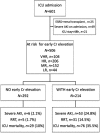Utilization of small changes in serum creatinine with clinical risk factors to assess the risk of AKI in critically lll adults
- PMID: 24677553
- PMCID: PMC3974351
- DOI: 10.2215/CJN.05190513
Utilization of small changes in serum creatinine with clinical risk factors to assess the risk of AKI in critically lll adults
Abstract
Background and objectives: Disease biomarkers require appropriate clinical context to be used effectively. Combining clinical risk factors, in addition to small changes in serum creatinine, has been proposed to improve the assessment of AKI. This notion was developed in order to identify the risk of AKI early in a patient's clinical course. We set out to assess the performance of this combination approach.
Design, setting, participants, & measurements: A secondary analysis of data from a prospective multicenter intensive care unit cohort study (September 2009 to April 2010) was performed. Patients at high risk using this combination approach were defined as an early increase in serum creatinine of 0.1-0.4 mg/dl, depending on number of clinical factors predisposing to AKI. AKI was defined and staged using the Acute Kidney Injury Network criteria. The primary outcome was evolution to severe AKI (Acute Kidney Injury Network stages 2 and 3) within 7 days in the intensive care unit.
Results: Of 506 patients, 214 (42.2%) patients had early creatinine elevation and were deemed at high risk for AKI. This group was more likely to subsequently develop the primary endpoint (16.4% versus 1.0% [not at high risk], P<0.001). The sensitivity of this grouping for severe AKI was 92%, the specificity was 62%, the positive predictive value was 16%, and the negative predictive value was 99%. After adjustment for Sequential Organ Failure Assessment score, serum creatinine, and hazard tier for AKI, early creatinine elevation remained an independent predictor for severe AKI (adjusted relative risk, 12.86; 95% confidence interval, 3.52 to 46.97). Addition of early creatinine elevation to the best clinical model improved prediction of the primary outcome (area under the receiver operating characteristic curve increased from 0.75 to 0.83, P<0.001).
Conclusion: Critically ill patients at high AKI risk, based on the combination of clinical factors and early creatinine elevation, are significantly more likely to develop severe AKI. As initially hypothesized, the high-risk combination group methodology can be used to identify patients at low risk for severe AKI in whom AKI biomarker testing may be expected to have low yield. The high risk combination group methodology could potentially allow clinicians to optimize biomarker use.
Figures



Comment in
- 633–634 doi: 10.2215/CJN.01520214
References
-
- Hoste EA, Lameire NH, Vanholder RC, Benoit DD, Decruyenaere JM, Colardyn FA: Acute renal failure in patients with sepsis in a surgical ICU: Predictive factors, incidence, comorbidity, and outcome. J Am Soc Nephrol 14: 1022–1030, 2003 - PubMed
-
- Hoste EA, Schurgers M: Epidemiology of acute kidney injury: How big is the problem? Crit Care Med 36[Suppl]: S146–S151, 2008 - PubMed
-
- Bagshaw SM, George C, Bellomo R: A comparison of the RIFLE and AKIN criteria for acute kidney injury in critically ill patients. Nephrol Dial Transplant 23: 1569–1574, 2008 - PubMed
-
- Piccinni P, Cruz DN, Gramaticopolo S, Garzotto F, Dal Santo M, Aneloni G, Rocco M, Alessandri E, Giunta F, Michetti V, Iannuzzi M, Belluomo Anello C, Brienza N, Carlini M, Pelaia P, Gabbanelli V, Ronco C, NEFROINT Investigators : Prospective multicenter study on epidemiology of acute kidney injury in the ICU: A critical care nephrology Italian collaborative effort (NEFROINT). Minerva Anestesiol 77: 1072–1083, 2011 - PubMed
-
- Uchino S, Kellum JA, Bellomo R, Doig GS, Morimatsu H, Morgera S, Schetz M, Tan I, Bouman C, Macedo E, Gibney N, Tolwani A, Ronco C, Beginning and Ending Supportive Therapy for the Kidney (BEST Kidney) Investigators : Acute renal failure in critically ill patients: A multinational, multicenter study. JAMA 294: 813–818, 2005 - PubMed
Publication types
MeSH terms
Substances
LinkOut - more resources
Full Text Sources
Other Literature Sources
Research Materials
Miscellaneous

